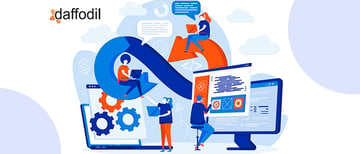.jpg?width=700&name=blog%20banner%20(14).jpg)
Every industry and business sector in the world has been making breakthroughs in widespread Artificial Intelligence (AI) implementation. This has been so prevalent that the very landscape of AI has been constantly transforming. The accumulation of so many breakthroughs is ushering in a new stage for AI; referred to popularly as AI 2.0.
There have roughly been 60 years in AI's developmental history but the core idea behind the implementation of AI remains the same. The end goal towards continually developing the capabilities of AI is to aid in human tasks and to complement human intelligence and analytical skills.
Numerous mergers and acquisitions across industries and an influx of limitless capital are some things that have accelerated the growth of AI in recent years. Voice-activated assistants, image-based diagnosis of illnesses, social media customer insights gathering, and self-driven cars are just some of the areas of ongoing AI expansion.
In this article, we will discuss how the next phase of AI innovation will be implemented. But first, let us begin by exploring the various driving forces necessitating the development of AI 2.0.
What Is Driving The Promotion Of AI 2.0?
Innovations in AI have always depended on its compatibility with variations in the general information environment. The universal expansion in sensors, development of e-commerce, rise of Big Data and more people now in possession of AI-related skills are pushing towards the massive promotion of a new evolutionary stage for AI; AI 2.0.
The following are some of the factors necessitating more innovations towards AI 2.0:
- Technology Infrastructure Upgrades
Sensors, mobile terminals, and wearable devices are some of the leading advancements in the technology infrastructure of today. There has been extensive embedding of sensors in virtually every machine, accompanied by the unprecedented rapid expansion of connectivity. This increase in the volume and complexity of technology has mandated the evolution of AI to support human efforts to manage these technologies.
- Social Demands
The demands for AI research are not just limited to academic circles as they used to be but have spilled over to core industries and businesses. Interest areas where AI can be implemented include a wide variety of implementations and include smart cities, medicine, transportation, logistics, manufacturing, etc. So, many enterprises are proactive about the adoption of AI as well as accompanying research to usher in the AI 2.0 revolution.
- Changing Goals
Initially, the goal that went behind the development of incrementally more advanced AI was the simulation of human intelligence. But this interest soon transformed into creating enhanced hybrid intelligence systems combining human and machine intelligence. Then came the evolution to crowd intelligence systems involving machines, humans, and networks followed by the upcoming AI 2.0 combination of humans, societies, physics, and cyber systems known as complex intelligence systems.
- Data Resources Changing
As the effectiveness of AI relies heavily upon data-driven algorithms, a change in the volume of data sources today is another driving force behind AI 2.0. Big Data and increasing cross-media information exchange are making the evolution of AI technologies an inevitable trend for the coming age of technological innovation. Significant advancements in AI are going to be necessary to support analytics and parsing of ever-increasing volumes of various businesses' user data.
Customer Success Story: Rebuilding an AI and IoT-based multi-source health tracking app
How AI 2.0 Will Be Implemented
In the last decade or so, enterprises and industrial conglomerates have migrated their operations extensively to online environments and cloud providers. This migration has paved the way for highly scaled-up computing capabilities that handle more and more complex and voluminous data. These changes are eventually going to crescendo into the large-scale implementation of AI 2.0. The following are some ways in which it will be implemented across corporations and business sectors:
- Promotion By Tech Decision Makers
While AI was being applied completely by data scientists with little to no involvement from the top-level executives of the company, not much in terms of technology evolution could be expected. AI implementation in enterprises must be a topic of open discussion across the organizational structure. Sufficient congruence between AI aspirations to the budget, processes, and objectives of the organization must be ensured.
C-suite executives who form the top layer of any enterprise's management chain of command must be well educated in the capabilities of AI. A survey from Appen finds that both C-suite ownership of AI and budgets over $ 500,000 in 2020 were nearly twice those of 2019. This shows that there is an increase in top-level involvement in AI innovation which is sure to allow a smooth transition to AI 2.0.
- Diversification Of Data Scientist Roles
The AI 2.0 paradigm is going to need a huge number of advanced skills and people with expertise in machine learning, deep pipeline engineering, AIOps, and CloudOps. The translation of work from the research sphere managed largely by data scientists to the production environment must be seamless for the shift to the evolution of AI technologies.
There are several sophisticated technology platforms and packaged solutions that employ niche skills of manipulation and management. The current technology jobs market is seeing an increase in roles that involve some form of data science and that is an early sign of AI 2.0.
- Adoption Of Deeper Algorithms
The current real-world applications of AI for predictive analytics and image processing leverage very shallow algorithms that are based on supervised learning. The nascent stages of AI 2.0 are showing up in the research involving a variety of modeling approaches such as semi-supervised and self-supervised learning.
We need to focus on building algorithms, AI approaches, and strategies that go beyond merely identifying data patterns. There must be extensive research and development of intelligent systems that derive deeper insights from enterprise data and customer engagement.
- Broader Automation And Intelligent Systems
The enterprise AI 2.0 paradigm must go beyond the scope of simple process automation and tactical advantages. Entire business processes and decision-making must be sharpened with the capabilities of AI for more nuanced and somewhat unbiased enterprise decisions. Not just e-commerce and digital marketing, these capabilities can also be employed in world governance.
Issues with human involvement such as imprecisions, non-compliance, and cognitive biases can be nullified with greater dependability on AI. AI-based decision-making, which will likely be a huge part of AI 2.0, must also be supervised by data scientists and taken through much human scrutiny for effective results.
ALSO READ: Why Do Industries Need Explainable AI?
Greater Adoption Of AI Will Make Enterprises Work More Efficiently
AI 2.0 will usher in more diverse applications of artificial intelligence for cross-media cognition, self-supervised learning, and autonomous inference. Enterprises will be able to depend on AI, not just for process automation, but also for decision-making in areas that make a difference.
Interpretation of complex data, assistance in critical business decision-making, and self-learning intelligent systems are every company's needs. To know what Daffodil can do for your company in this regard, book a free consultation today.



